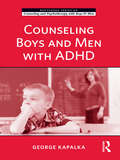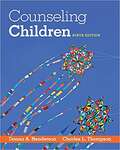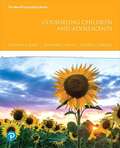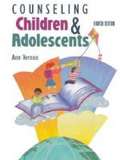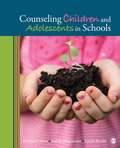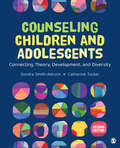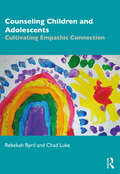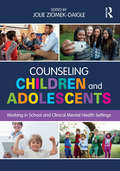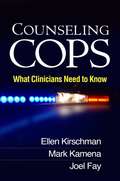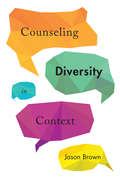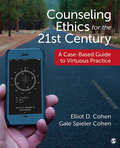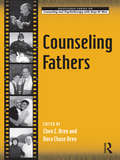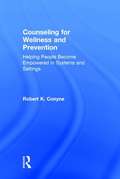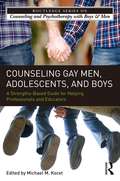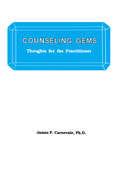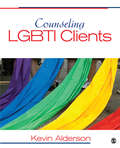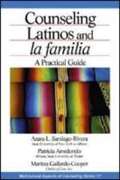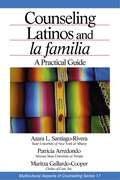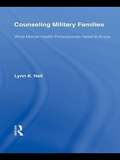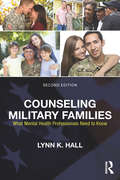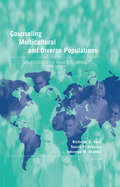- Table View
- List View
Counseling Boys and Men with ADHD (The Routledge Series on Counseling and Psychotherapy with Boys and Men)
by George KapalkaAttention-deficit hyperactivity disorder primarily affects boys and male teens, and the symptoms can continue on into adulthood. Consequently, clinicians need to be well-versed in techniques to treat this disorder that are tailored specifically to the needs of males; there are, however, few resources available to them. This guidebook provides a review of the counseling, educational, and medical interventions that can benefit boys and men with ADHD. Kapalka begins with a review of symptoms, etiology, assessment, and diagnosis and then discusses a variety of specific interventions: individual counseling, parenting techniques, classroom interventions, and group counseling techniques. The use of medication in conjunction with counseling is also considered. Throughout all of the topics covered, Kapalka emphasizes what it is like to be male and have ADHD and describes the impacts that masculinity and gender expectations can have on the expression of and response to the disorder.
Counseling Children
by Donna A. Henderson Charles L. ThompsonCOUNSELING CHILDREN covers the most practical and up-to-date methods for developing effective approaches to counseling children. To help prepare you for your career, the authors translate theory into practice by focusing on the application of ideas and current knowledge. This easy-to-read guide includes useful strategies and case studies to provide you with a realistic look at the counseling field. It also presents a development approach to counseling that considers age and stage differences in counseling children, adolescents, and adults. The ninth edition includes 2014 ACA ethical standards, best practice guidelines, and fresh ideas that facilitate your understanding of the world of the child. Expanded coverage of children who have special concerns and of family interventions provides you with effective ways to deliver interventions across multiple settings.
Counseling Children and Adolescents
by Victoria E. Kress Matthew J. Paylo Nicole A. StargellA practical, evidence-based introduction on counseling children and adolescents. This book empowers counselors to thoughtfully and deliberately help young clients tackle complex issues and difficulties. The text covers the principal approaches to counseling children and adolescents, discusses the common issues that bring children and adolescents to counseling, and helps readers understand what counseling younger people looks like. What sets this work apart are its concrete applications and its clear, accessible writing. As one reviewer put it, the text's key strengths are a "practical synthesis of theory into clinical and school counseling..., engaging case studies that are diverse and multiculturally sensitive..., [and] real world application."
Counseling Children and Adolescents 4th Edition
by Ann VernonThis new edition has been revised considerably to include even more practical information and "how to" strategies for counseling children and adolescents, as well as for working with families and parents. The authors present numerous empirically based approaches that are developmentally and culturally appropriate for counseling children. This text offers helpful information on the individual and group counseling process and includes a plan for designing a developmental counseling curriculum from primary grades through high school. Comprehensive, up-to-date chapters specifically address counseling children who are at risk or who have special needs and children and adolescents from diverse backgrounds. Chapters on play therapy, rational-emotive behavior therapy, and brief therapy specifically describe how to apply these approaches with children and adolescents. The rich experiences of the authors as both practitioners and clinicians, in addition to being counselor educators, bring a wide array of innovations and creative techniques to this new volume.
Counseling Children and Adolescents in Schools
by Linda Beeler Sandy Magnuson Robyn S. HessCounseling Children and Adolescents in Schools is a text and practice and application guide designed to help aspiring school psychologists and counselors gain the necessary theoretical background and skill set to work effectively with youth in schools. The dual focus on school counselors and school psychologists provides students a broader view of the different mental health professionals in the schools, with an emphasis on collaboration. This interdisciplinary text can be used across pre-practica, practica, and other school-based field experiences.
Counseling Children and Adolescents: Connecting Theory, Development, and Diversity (Counseling and Professional Identity)
by Mary Catherine Tucker Sondra L. Smith-AdcockCounseling Children and Adolescents, Second Edition reviews the most relevant theoretical approaches for counseling children (CBT, emotion focused therapy, play therapy, systems theory and developmental theories) and focuses on connecting key theories to application via case studies. The book has an integrated framework that focuses on development and diversity. In addition, a unique aspect of this text is its focus on neuroscience, the developing brain, and the impact of early childhood trauma on development. Updates to the second edition include new coverage of the multicultural ethical decision model, intersectionality, implicit bias, the impact of the COVID-19 pandemic, and new research and citations.
Counseling Children and Adolescents: Connecting Theory, Development, and Diversity (Counseling and Professional Identity)
by Mary Catherine Tucker Sondra L. Smith-AdcockCounseling Children and Adolescents, Second Edition reviews the most relevant theoretical approaches for counseling children (CBT, emotion focused therapy, play therapy, systems theory and developmental theories) and focuses on connecting key theories to application via case studies. The book has an integrated framework that focuses on development and diversity. In addition, a unique aspect of this text is its focus on neuroscience, the developing brain, and the impact of early childhood trauma on development. Updates to the second edition include new coverage of the multicultural ethical decision model, intersectionality, implicit bias, the impact of the COVID-19 pandemic, and new research and citations.
Counseling Children and Adolescents: Cultivating Empathic Connection
by Chad Luke Rebekah ByrdCounseling Children and Adolescents focuses on relationship building and creating a deep level of understanding of developmental, attachment, and brain-based information. Chapters place a clear emphasis on building strengths and developing empathy, awareness, and skills. By going beyond theory, and offering a strengths-based, attachment, neuro- and trauma-informed perspective, this text offers real-world situations and tried and true techniques for working with children and adolescents. Grounded in research and multicultural competency, the book focuses on encouragement, recognizing resiliency, and empowerment. This book is an ideal guide for counselors looking for developmentally appropriate strategies to empower children and adolescents.
Counseling Children and Adolescents: Working in School and Clinical Mental Health Settings
by Jolie Ziomek-DaigleCounseling Children and Adolescents gives students the information they need to prepare for work in both school and clinical mental health settings (two CACREP—Council for Accreditation of Counseling and Related Educational Programs—specialty areas). This text includes not only content related to developmental and counseling theories but also information on evidence-based practices across the continuum of care, diagnosis and treatment of youth, and current trends such as integrated care, mindfulness, and neuroscience. Unique to this book are sections on both the instructional and behavioral Response to Intervention (RtI) model and PBIS, examples of evidence-based practices used across settings such as Student Success Skills, Check & Connect, and trauma-focused CBT, and a review of common mental health-related disorders most often seen in youth and treatment recommendations. Ethical and legal implications are infused throughout the book, as are CACREP learning outcomes. Instructors using this textbook can also turn to its companion website to access test questions for each chapter. Expansive and practical, Counseling Children and Adolescents fills a gap in counselor preparation programs and provides an important resource that can be used across specialty areas and coursework.
Counseling Children and Adolescents: Working in School and Clinical Mental Health Settings
by Jolie Ziomek-DaigleExpansive and practical, Counseling Children and Adolescents offers graduate students the information they need to prepare for work in both school and clinical mental health settings (two CACREP specialty areas). This text includes not only content related to developmental and counseling theories but also information on evidence-based practices across the continuum of care, diagnosis and treatment of youth, and current trends such as integrated care, mindfulness, telehealth, and neuroscience. Unique to this book are sections on both the instructional and behavioral Response to Intervention (RtI) model and Positive Behavioral Interventions and Supports (PBIS), examples of evidence-based practices used across settings such as Student Success Skills, Check & Connect, and trauma-focused CBT, and a review of common mental health-related disorders most often seen in youth and treatment recommendations. Ethical and legal implications are infused throughout the book, as are CACREP learning outcomes. The new edition uses a trauma-informed and anti-racist lens and fills a gap in counselor preparation programs. A testbank is available to instructors at www.routledge.com/9781032532455.
Counseling Cops
by Ellen Kirschman Joel Fay Ellen Scrivner Mark KamenaGrounded in clinical research, extensive experience, and deep familiarity with police culture, this book offers highly practical guidance for psychotherapists and counselors. The authors vividly depict the pressures and challenges of police work and explain the impact that line-of-duty issues can have on officers and their loved ones. Numerous concrete examples and tips show how to build rapport with cops, use a range of effective intervention strategies, and avoid common missteps and misconceptions. Approaches to working with frequently encountered clinical problems--such as substance abuse, depression, trauma, and marital conflict--are discussed in detail. See also Kirschman's related self-help guide I Love a Cop, Revised Edition: What Police Families Need to Know, an ideal recommendation for clients and their family members.
Counseling Diversity in Context
by Jason BrownWellness is an important goal of counseling work, but the limits of promoting it are reached more quickly for individuals living in disadvantaged circumstances. How then can counselors be effective in a context that produces and reproduces structural inequality? In Counseling Diversity in Context, Jason Brown addresses this question, exploring the possibilities and limitations of counseling, as well as the forces that help and hinder communities, while demonstrating the need for alternatives to mainstream psychological approaches. Divided into two parts, the book provides a structural understanding of the context in which cross-cultural counseling takes place, and a model, informed by intersectional analysis, to support counselors in playing a more activist role in helping to change that context. Brown encourages counselors to not only understand the social problems that contribute to personal challenges faced by clients but to also raise awareness and promote change.
Counseling Ethics for the 21st Century: A Case-Based Guide to Virtuous Practice
by Elliot D. Cohen Gale S. CohenCounseling Ethics for the 21st Century prepares students to address ethical issues arising in contemporary counseling practice. Drawing on their own clinical and practical experiences, authors Elliot D. Cohen and Gale Spieler Cohen present detailed, realistic, and engaging clinical case studies along with a comprehensive five-step model that can be used to manage the complex ethical problems raised throughout the book. Each chapter focuses on particular virtues in the context of examining a particular counseling issue, including online counseling, digital record keeping, and social media. Students will be empowered to define problems, identify relevant facts, conduct ethical analyses, and make the best decisions for their clients.
Counseling Ethics for the 21st Century: A Case-Based Guide to Virtuous Practice
by Elliot D. Cohen Gale S. CohenCounseling Ethics for the 21st Century prepares students to address ethical issues arising in contemporary counseling practice. Drawing on their own clinical and practical experiences, authors Elliot D. Cohen and Gale Spieler Cohen present detailed, realistic, and engaging clinical case studies along with a comprehensive five-step model that can be used to manage the complex ethical problems raised throughout the book. Each chapter focuses on particular virtues in the context of examining a particular counseling issue, including online counseling, digital record keeping, and social media. Students will be empowered to define problems, identify relevant facts, conduct ethical analyses, and make the best decisions for their clients.
Counseling Fathers (The Routledge Series on Counseling and Psychotherapy with Boys and Men)
by Chen Z. Oren Dora Chase OrenMen do not often come for counseling because they are having difficulties with being a father, but many of the presenting problems and reasons for seeking help can be related to the roles and responsibilities of fathering. The dramatic shift in societal expectations of being a father can often leave men confused as they navigate conflicting views, demands, and responsibilities. Counseling Fathers is designed to bridge the gap between fathers and professional helpers. This book provides the mental health practitioners with a guide for working with fathers in therapy, whether the issues of fathering are at the center of the discussions or in the background. The organization of the book speaks to the variety of today's fathers and the issues that they face. Part I provides an historical overview of the fathering movement, a strength-based approach to working with fathers, and an assessment paradigm using gender role conflict theory. Part II takes a cross-cultural approach, with a series of chapters that look at counseling with Latino, Asian, Black, and Caucasian fathers. Part III looks at specific populations of fathers, including first time fathers, teen fathers, stay-at-home fathers, gay fathers, and older fathers. Counseling Fathers provides the most up-to-date and comprehensive resource for family and individual practitioners who work with men who father.
Counseling For Wellness And Prevention: Helping People Become Empowered In Systems And Settings
by Robert ConyneCounseling for Wellness and Prevention brings Preventative Counseling, one of prevention’s founding texts, firmly into the twenty-first century. Counseling for Wellness and Prevention thoroughly updates and significantly expands on discussions of practical applications and emerging best practices. Counselors and counseling psychologists will find evidence-based, contemporary guidance to help them engage in needed efforts to help clients and the general population to enhance their overall wellness and ward off future dysfunction. Author Robert Conyne demonstrates the ways in which the traditional model of one-to-one therapy can be expanded to embrace wellness and prevention as well as strategies for putting into practice a broad range of environmental and system change strategies, such as advocacy and community organization. The book is well-suited for adoption in counselor-education courses and includes explicit connections to CACREP accreditation standards. It’s also an excellent choice for programs in psychology, where the APA-approved prevention guidelines for psychologists are now available, and in social work, where prevention and community change have long been hallmarks.
Counseling Gay Men, Adolescents, and Boys: A Strengths-Based Guide for Helping Professionals and Educators (The Routledge Series on Counseling and Psychotherapy with Boys and Men)
by Michael M. KocetCounseling Gay Men, Adolescents, & Boys: A Strengths-Based Guide for Helping Professionals and Educators provides practitioners and educators with critical information needed to help navigate the therapeutic and educational terrain of working with gay males. While other books address a broad range of issues when working with LGBTQ individuals, this volume devotes its focus to the specific needs of gay boys, adolescents, and men. This book also presents an important perspective about individuals who identify as bisexual and transgender, and examines the intersection between gender and sexual orientation. Readers will find practical resources, tools, and clinical case studies for mental health practitioners, professionals in school settings, educators, administrators, and medical personnel serving gay males.
Counseling Gems: Thoughts For The Practitioner
by James P. CarnevaleFirst published in 1989. Routledge is an imprint of Taylor & Francis, an informa company.
Counseling Kids
by Donald L. PetersFirst published in 1991. Routledge is an imprint of Taylor & Francis, an informa company.
Counseling LGBTI Clients
by Kevin G. AldersonCounseling LGBTI Clients is a comprehensive, practical, easy-to-read guide for both emerging practitioners and current practitioners, LGBTI individuals, and those who know them. It combines theory, research and practice with a framework that focuses on challenging and changing beliefs and attitudes toward each LGBTI subgroup, gaining current knowledge about the subgroup, and empathetically developing skills to work effectively with the subgroup in a LGBTI-affirmative manner.
Counseling Latinos and La Familia: A Practical Guide
by Azara L. Santiago-Rivera Patricia Arredondo Maritza Gallardo-CooperThis handbook for counselors offers an integrated approach to understanding Latino families. It provides background information concerning the Latino population and the family unit, its place in Latino culture, the diversity of Spanish- speaking groups, socio-political issues, and changing family forms. Practical counseling approaches are described, with an emphasis on the multicultural competencies approach. The authors include practicing psychologists, scholars of psychology, and scholars of Latin American studies. Annotation c. Book News, Inc. , Portland, OR (booknews. com)
Counseling Latinos and la familia: A Practical Guide (Multicultural Aspects of Counseling series)
by Maritza Gallardo-Cooper Patricia Arrendondo Azara L. Santiago-RiveraCounseling Latinos and la familia provides an integrated approach to understanding Latino families and increasing competency for counselors and other mental health professional who work with Latinos and their families. It provides essential background information about the Latino population and the family unit, which is so central to Latino culture, including the diversity of various Spanish-speaking groups, socio-political issues, and changing family forms. The book also includes practical counseling strategies, focusing on the multicultural competencies approach.
Counseling Military Families
by Lynn K. HallAccording to the United States Department of Defense, by the end of 1993 there were 2,036,646 reservists and family members and 3,343,235 active duty and family members for a total of 5,379,781 people affected by the military. Since then, because of the conflict in Iraq, the numbers have dramatically increased. While we have always had military families in our midst, not since the Vietnam War have their struggles been so vivid, particularly with alarming rates of increase of both suicide and divorce among military personnel. The face of the military has changed; for the first time a volunteer army is serving in a major combat zone, the level of reservists serving is unprecedented, the percentage of women soldiers in virtually all positions is unprecedented and most of the soldiers have left spouses and/or families behind. The objectives of Counseling Military Families are to help the practicing counselor understand how the military works, what issues are constants for the military family, and what stressors are faced by the military member and the family. The book will begin with an overview of military life, including demographic information and examples of military family issues, before delving into specific chapters focused on the unique circumstances of reservists, career service personnel, spouses, and children. The final section of the book will present treatment models and targeted interventions tailored for use with military families. This book will help counselors tailor their interventions to work well with families who are in transition, who may have an ingrained resistance to asking for help and who will, more than likely, be available for counseling for a relatively short period of time.
Counseling Military Families: What Mental Health Professionals Need to Know
by Lynn K. HallHow does the military really work? What issues are constants for military families, and what special stresses do they face? Counseling Military Families provides the best available overview of military life, including demographic information and examples of military family issues. Chapters focus on vital issues such as the unique circumstances of reservists, career service personnel, spouses, and children, and present treatment models and targeted interventions tailored for use with military families. Counseling Military Families provides clinicians with the tools they need to make a difference in the lives of families in transition, including those who may have an ingrained resistance to asking for help and who may be available for counseling for a relatively short period of time.
Counseling Multicultural and Diverse Populations: Strategies for Practitioners (Fourth Edition)
by Nicholas A. Vacc Susan B. DeVaney Johnston M. BrendelThe purpose of this book is to expose students of the helping professions, counselors, teachers, college professors, mental health workers, and social workers to the unique characteristics of representative American subgroups and to effectively assist these same professionals as they work with clients and/or students from these populations. These are grouped by race, gender, sexuality, age, physical limitations and lifestyle etc. The author of each chapter is both a trained helping professional and a member of the group in question. This unique combination of qualifications lends both an academic and a personal perspective to the understanding of the populations represented.
